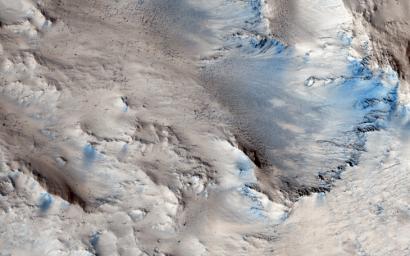
|
Sedimentary Fans North of Mojave Crater
- Click the image above for a larger view
- Full-Res JPEG (2880 x 1800) (839.9 kB)
- Full-Res TIFF (2880 x 1800) (15.6 MB)
Caption:

Map Projected Browse Image
Click on the image for larger version
In this observation, does the morphology of these possible sedimentary fans match those found in Mojave Crater?
A high resolution image can be useful to determine systematic changes in boulder size (an indication of how much energy moved the sediment) or channel characteristics (e.g. width, depth) with distance from Mojave. Is fan stratigraphy, erosional state, and crater density consistent with Mojave as a source of the sediment?
Mojave Crater is special on Mars due to the evidence in and surrounding it that rain may have fallen there in Mars' past. Rain is thought to have been overwhelmingly, exceedingly rare in Mars' history, though a local rain event could have been caused by the heat of the impact that formed Mojave Crater.
Note: Mojave Crater is not pictured in this observation.
Background Info:
HiRISE is one of six instruments on NASA's Mars Reconnaissance Orbiter. The University of Arizona, Tucson, operates HiRISE, which was built by Ball Aerospace & Technologies Corp., Boulder, Colorado. NASA's Jet Propulsion Laboratory, a division of the California Institute of Technology in Pasadena, manages the Mars Reconnaissance Orbiter Project for NASA's Science Mission Directorate, Washington.
Cataloging Keywords:
| Name | Value | Additional Values |
|---|---|---|
| Target | Mars | |
| System | ||
| Target Type | Planet | |
| Mission | Mars Reconnaissance Orbiter (MRO) | |
| Instrument Host | Mars Reconnaissance Orbiter | |
| Host Type | Orbiter | |
| Instrument | High Resolution Imaging Science Experiment (HiRISE) | |
| Detector | ||
| Extra Keywords | Color, Crater, Impact, Map | |
| Acquisition Date | ||
| Release Date | 2015-01-15 | |
| Date in Caption | ||
| Image Credit | NASA/JPL-Caltech/University of Arizona | |
| Source | photojournal.jpl.nasa.gov/catalog/PIA19129 | |
| Identifier | PIA19129 | |
